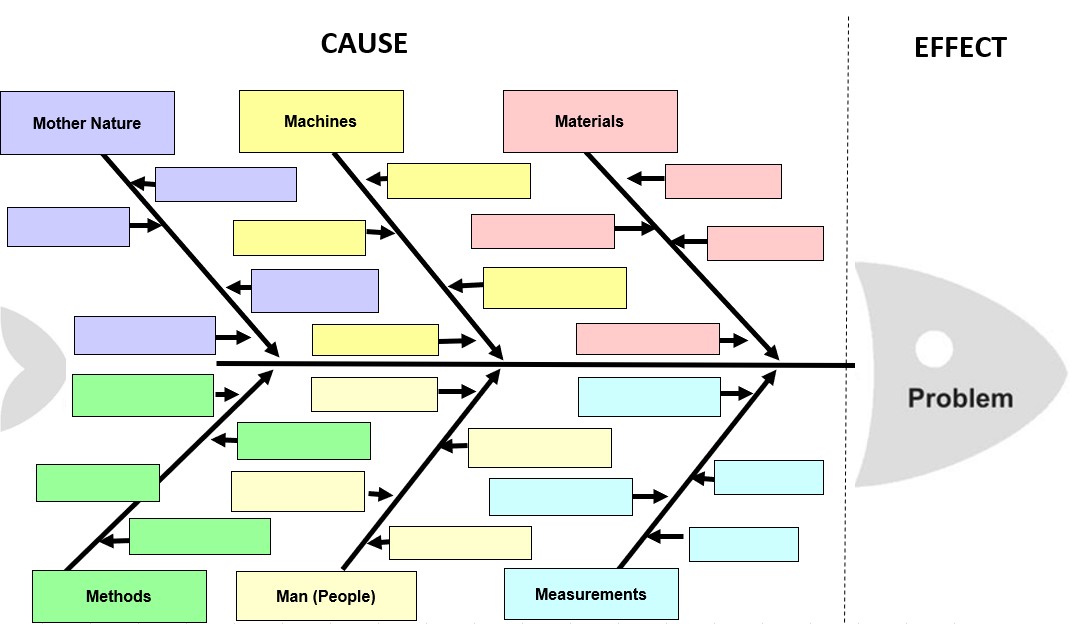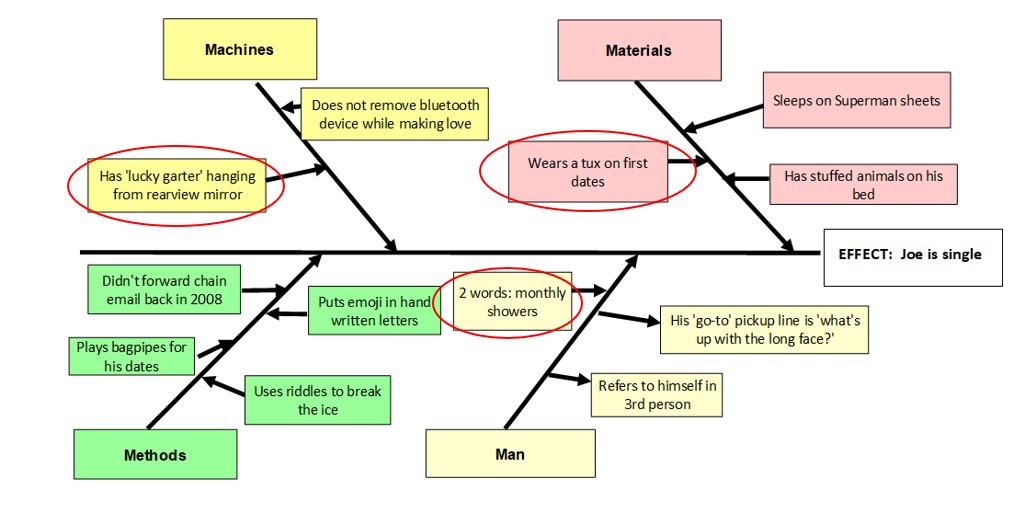Reel in the Cause of Your Problem with a Fishbone Diagram!
The fishing is usually pretty good in Miami, at least it is for me. Unfortunately, for a good friend of mine named ‘Joe’ that hasn’t been the case lately. We were catching up over a beer recently and he was lamenting how despite the fact that he goes fishing every day, he has been mostly unsuccessful. He does get some bites, and he does get them on the line from time to time. The problem is, when he tries to reel them in, they usually end up squirming to get off the hook and end up swimming away.
After listening to a story about another one that got away, it was clear to me the reason for his lack of success and the direction he needed to go in order to be more successful.
“Joe”, I said. “Before you do any more fishing, I think we need to get you some ‘reel’ exposure to fishbone diagrams.”
At that point he clammed up and listened to me intently, it was clear that I had this bottom-feeder’s attention. We will get back to Joe’s story in a little bit, but first…
When you have a problem in your life, the last thing you should do…
…is to attempt to solve it without first knowing what caused it. Otherwise, you may just be addressing a symptom of the problem. Which means that whatever action you take will not solve the problem. This will result in you having to go back and address the problem again in the future. By identifying the root cause, you will increase the chances that you solve the problem correctly – the first time around!
What is a Fishbone Diagram
A fishbone diagram, also known as a cause and effect (C&E) diagram or “Ishikawa diagram” is a tool that was invented back in the 1960’s by quality pioneer Kaoru Ishikawa.
The main purpose of a fishbone or cause and effect diagram is to help you brainstorm the potential causes of your problem (also known as the effect) – hence the reason it is called a cause and effect diagram. The reason it is called a fishbone is that as you will see below, it looks like a fishbone. If you can’t figure out why it is called an “Ishikawa diagram” – stop reading and go do something else – this blog is definitely not for you.
People are frequently overwhelmed by the number of causes related to a problem.
Using a cause and effect or fishbone diagram helps a team or individual identify the various causes and narrow them down to the most probable cause(s) by:
 Organizing the potential causes of a problem (called an effect), usually because there are so many potential causes of a given problem.
Organizing the potential causes of a problem (called an effect), usually because there are so many potential causes of a given problem.
 Selecting the most probable causes of the problem (effect).
Selecting the most probable causes of the problem (effect).
 Verifying the cause and effect relationship between the problem (effect) and the most probable cause(s).
Verifying the cause and effect relationship between the problem (effect) and the most probable cause(s).
This is What it Looks Like!
Below is a generic example of a fishbone diagram. The problem (effect) we are trying to find the cause of is inside the fish head, while the potential root causes of the problem are on the fishbones. The smaller the fishbone, usually, the more actionable the cause is to fix.
As you can see, the fishbone diagram consists of a ‘head’ which then has a horizontal line attached to it (the spine), there are then 6 vertical lines coming out from the spine, each of which is labeled with a category name. From there you will see horizontal lines jutting out. These are the potential causes of the problem. You may also see further lines (not pictured), which are the sub-causes.
In the fishbone diagram below, you will see 6 categories: mother nature, machines, materials, methods, man (people), and measurements. You can use these generic categories, or you can create your own based on the problem you are trying to solve.

Now That You Know…
…what a fishbone diagram looks like, it is time to brainstorm for all the possible causes of the problem (effect).
Once you have defined the problem and entered it into the head of the fishbone diagram and labeled the categories, it is time to get to work.
You start by brainstorming potential causes for the problem under each category and then draw a line off of the spine of the fishbone diagram for each category and then label each line with the cause.
Then, you can keep asking ‘why?’ and add sub-causes under each line to get deeper into the true causes(s) of the problem – if applicable.
Once you have filled out the fishbone diagram by going through each category and adding causes and sub-causes, it is time to analyze your fishbone diagram.
How you analyze the diagram will all depend on how complex and important the problem is. Typically, you go through it and circle the causes or sub-causes you believe are most responsible for the problem.
Then, you can do further due diligence, ask more questions, do further investigation, collect data to really make sure you have pinpointed the root cause(s) etc.
Finally, it is time to come up with a solution that addresses the root cause(s) of the problem and implement it.
Back to My Pal Joe
After going through the fishbone diagram concept with him, he understood that he needed to create one. He started by putting his problem in the head of the fish which was…that he is single.
WAIT, did you think he was literally going fishing for fish? Looks like I got you – hook, line, and sinker!
Anyway, he then chose 4 categories (machine, materials, methods, and man) and started brainstorming potential causes under each.

We met a couple of weeks later, and he brought the fishbone diagram with him and asked if I could help him analyze it – which of course I was happy to do.
“Holy mackerel,” I thought to myself, “no wonder this dude is single, he is a fish out of water in South Florida!”
I quickly caught myself and tried to be positive – while he is an odd fish there are a lot of fish in the sea.
We went through his fishbone diagram to see if we could fish out the causes and circled what I thought were the root causes or the showstoppers for him being single.

While they were all potential reasons for him being single, the ones we circled needed to be addressed first as they were scaring the fish off immediately.
We then came up with a plan for each:
(1) We got rid of the ‘lucky garter’ – I’m still shaking my head at that one.
(2) I took him shopping so he that had something better to wear than a tux on his first dates.
(3) Lastly, he agreed to daily showers.
To make a long story longer, Joe somehow ended up landing the catch of his dreams. The fish’s name? Wanda! Ha! Go figure!
I hope you had a whale of a time reading this blog post and learning about fishbone diagrams. Remember, “Give a man a fish and you feed him for a day, teach a man to fish and you feed him for a lifetime.”
Until next time…Prime Your Pump – fish stories told here…’some’ true! 😉
–Captain Rick
When to Use It?
There are several specific areas where you can use a fishbone diagram:
 To discover the root cause of a personal or work problem.
To discover the root cause of a personal or work problem.
 When you don’t have a lot of qualitative data needed to establish the root cause of a problem.
When you don’t have a lot of qualitative data needed to establish the root cause of a problem.
 To help figure out why you are wasting time or stuck on something.
To help figure out why you are wasting time or stuck on something.
 To figure out why something isn’t working.
To figure out why something isn’t working.
 When your thinking falls into a rut that you need to break out of.
When your thinking falls into a rut that you need to break out of.
 To structure a brainstorming session.
To structure a brainstorming session.
How to Create a Fishbone Diagram – Use it or Lose It
The following steps are recommended for constructing a fishbone diagram.
(1) State the problem, which is the effect.
(2) Select the team.
(3) Identify the major categories (you can use categories related to the specific problem or the generic 6 M’s (materials, machines, mother nature, methods, man and measurement).
(4) Brainstorm major causes under each category and label the resulting fishbones.
(5) Add sub causes (if applicable) under each by asking ‘why?’.
(6) Analyze the diagram and circle causes and sub-causes that you believe are most likely contributing to the problem.
(7) Prioritize the potential causes and sub-causes.
(8) Conduct further due diligence, ask more questions, do further investigation, collect data to really make sure you have pinpointed the root cause(s).
(9) Come up with a solution that addresses the root cause(s) of the problem and then implement it.
What Do You Think?
Have you ever used a fishbone diagram? Can you see yourself using it? Please share in the comments below!
References
Gitlow, H. Melnyck, R., and Levine, D. (2015), A Guide to Lean Six Sigma and Process Improvement for Practitioners and Students: Foundations, DMAIC, Tools, Cases and Certification, 2nd, edition, Prentice-Hall Publishers (Old Tappan, NJ)
If you enjoyed this post, it would mean the world to us if you shared it with people you care about via any of the social media platforms below!
Popular Previous Posts:
Why You Should Never Go to Bed Angry!
This is What Flip Cup Taught Me About Critical Path
This is Why the 12 Laws of Karma Definitely Aren’t a B****!
3 Popular Note-Taking Methods You Need to Make a Note Of!
This is How to Use Gamification to Make Boring Tasks Fun!


I have not used a fishbone diagram for problem solving, but have heard of the concept and know how it is supposed to work. Anyhow, this essay can only be described in one word – hilarious. With someone having difficulty in catching “fish” I thought of several things – wrong type of bait or lure, not paying attention to the tide tables, possible presence of alligators, dangling your hook out in the main channel instead of close to shore – you know, real fishing situations. Nice sneaky transition from fishing for fish to fishing for chicks. And when he does catch one, she’s named Wanda. That’s brilliant!
I thought immediately of the Fish Song, quite popular in Florida when I lived in Cocoa Beach during the late 80’s. With a bit of googling, I located the words here –
http://www.tripletsandus.com/cgi-bin/_boards/topic.cgi?forum=3&topic=411
So I gotta ask – how come you are still single. Are you dangling the wrong type of bait? Perhaps someone should do a fishbone on you. But I will leave that for Howie to figure out.
Thanks, Dave. Appreciate it. I just checked out the ‘fish song’ – WAY too funny and clever, love it! Thanks for sharing! As for me, working on luring in the big one. Be good and have a fantastic weekend! Rick